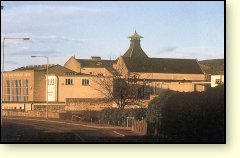
Location: Craigellachie, Aberlour, Banffshire
Roads: On hill to the south of the village
Phone: 01340-881212
|
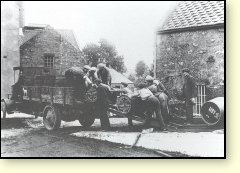
Even back in the roaring twenties, White Horse Whisky had its distinctive logo, seen here on the side of a ‘horseless cart’.
|
Craigellachie village makes the very best of a spectacular site, terracing its cottages into a hill that looks on to the meeting of the Rivers Spey and Fiddich. Telford’s little Meccano bridge of granite and cast iron across the Spey itself dates from 1814. The sign-writing on the modern distillery of Craigellachie declares clearly its associations with White Horse blended whisky and indeed the originator of the brand, the dynamic Peter Mackie, was one of its first partners when the distillery opened in 1891.
Apart from Peter Mackie, the other main mover in setting up Craigellachie was estate-owner Alexander Edward who was a well-known distillery promoter and entrepreneur at the time. He had inherited Benrinnes distillery from his father and became involved in running many distilleries like Dallas Dhu, Aultmore and others. He also leased out his own estate land near Forres for distillery ventures such as Benromach. Edward withdrew from the partnership in Craigellachie in 1900 and by 1915 Mackie had control of the business.
The original distillery was another of those designed by Charles Doig of Elgin but most of his structure was razed in the rebuilding of 1964/65. All that remains of his work are part of a warehouse and the original floor maltings, including the kiln and its external pagoda head roof. Ironically, some primitive accommodation bothies (shelters), already in situ before the distillery was built and used for a long time as temporary storage shelters, are still standing. There used to be a hamlet of 17 distillery houses nearby and in the 1920s the company gave annual prizes for the best-kept gardens. There are two pairs of stills, the second pair dating from 1965.
The Whisky
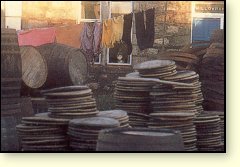
Barrel lids stacked up outside one of the Victorian cottages built to house workers at Craigellachie.
|
Craigellachie has an interesting combination of smoky pungency and lightish body. Some fruit and sweetness also show through. 14 year-old Craigellachie Malt is now bottled by United Distillers as a single malt and is sold at the distillery. Predictably the malt is used in the White Horse blends.
Source of water
Little Conval Hill
Of interest
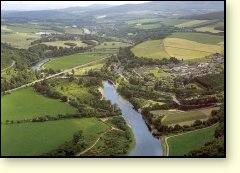
The River Spey meanders across the valley at Craigellachie. Some of the distilleries in this area are on raised sites, overlooking the river, and often tucked away in quieter valleys.
|
• Aberlour Visitor Centre has nutshell presentation of the history and heritage of the village and its environs.
• Ballindalloch Castle is the 16th-century seat of the Macpherson-Grants, local lairds on whose land many of the distilleries in the district first got going. The house represents a transition-point in Scottish fortified houses between the stark keep built for protection and the more comfortable but still secure country house. The gardens are lovely, with both the Spey and the Avon flowing through the grounds. There is a touch of Disney in the old bridge and gatehouse peeking out from the trees.
• Speyside Cooperage Visitor Centre at Craigellachie is attached to a large working cooperage and has a viewing gallery from which visitors may watch the coopers at work. Find out everything about coopering from the acorn to the completed cask.
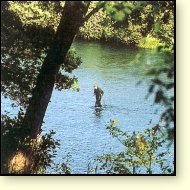
The river is renowned for its salmon fishing.
|
• The Malt Whisky Trail is a signposted route around eight distilleries in the Moray District and it also takes in the cooperage.
• Speyside Way Visitor Centre at Boat of Fiddich has complete access to information regarding the long-distance walkway that follows the line of the River Spey and thus passes the doors of a number of distilleries. A good alternative way to visit some of them.
• The Village Store in Aberlour has clothing, household effects and utensils from the early part of the century on display. A combination of nostalgia and curiosity builds up during visits.
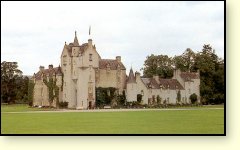
Ballindaloch Castle, dating back over 400 years, has a freshly scrubbed look that sets it apart from some of the smoke-blackened buildings of the distilleries.
|